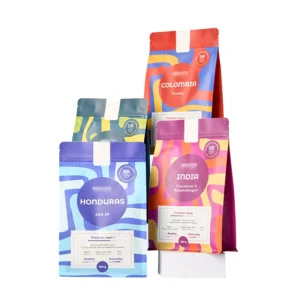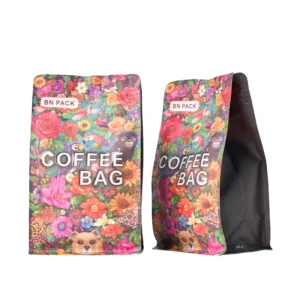Coffee bag printing is crucial for brand recognition and conveying freshness. The right method ensures your packaging stands out while preserving the quality of your beans. From flexographic to digital printing, each technique offers unique benefits, impacting both aesthetics and cost.
Choosing the optimal printing method for coffee packaging involves considering factors like print volume, design complexity, and material type. This guide explores the various options, helping you select the best approach to elevate your coffee brand’s presence.
What Are Coffee Bags
Recommended Coffee Bags
Coffee bags serve two primary purposes within the coffee industry: for bulk transport and storage of coffee beans, and for individual, single-serve brewing. Traditionally, large burlap or jute bags are used to transport green, unroasted coffee beans from farms to roasters. These bags are designed to be durable and breathable, allowing for proper ventilation and preventing moisture buildup that could damage the beans.
Coffee Bag Printing Methods
Coffee bag printing methods vary significantly, each offering distinct advantages. The choice depends on factors like volume, design complexity, and budget. From high-resolution digital prints to robust flexographic and premium rotogravure, understanding these techniques is crucial for effective branding.
Digital Printing
This method utilizes inkjet or laser technology to directly print designs onto the coffee bag material. It’s ideal for small to medium print runs, personalized packaging, and intricate designs with numerous colors. Digital printing offers high-resolution images and quick turnaround times, making it suitable for businesses that require frequent design changes or limited-edition packaging. It eliminates the need for printing plates, reducing setup costs and waste.
Digital printing allows for variable data printing, meaning each bag can have unique information, such as names, dates, or QR codes. This feature is valuable for promotional campaigns, personalized gifts, or tracking inventory. The process involves transferring digital artwork directly to the bag material, ensuring precise color matching and sharp details. However, it might not be the most cost-effective solution for large-scale production due to higher per-unit costs compared to other methods.
The versatility of digital printing extends to various bag materials, including paper, plastic, and laminated films. This method is particularly beneficial for businesses that prioritize sustainability, as it minimizes material waste and energy consumption. The ability to print on demand reduces the need for large inventory storage and allows for greater flexibility in responding to market trends.
Flexographic Printing
Flexographic printing, often referred to as flexo, uses flexible relief plates to transfer ink onto the coffee bag material. This method is well-suited for high-volume production and is known for its efficiency and cost-effectiveness. Flexo printing can handle a wide range of substrates, including plastic films, paper, and foil, making it a versatile option for various packaging needs.
The process involves creating a polymer plate with a raised image, which is then inked and pressed onto the bag material. Flexo printing can achieve high print speeds and consistent quality, making it ideal for large print runs. It’s commonly used for printing simple designs with solid colors and repeated patterns. While it can handle complex designs, it may not achieve the same level of detail as digital printing.
Flexo printing is a popular choice for businesses that require durable and long-lasting prints. The inks used in flexo printing are often water-based or solvent-based, offering good resistance to fading and abrasion. This method is also suitable for printing on flexible packaging materials, ensuring the print remains intact even when the bag is folded or creased.
Rotogravure Printing
Rotogravure printing, or gravure, employs engraved cylinders to transfer ink onto the coffee bag material. This method is known for its exceptional print quality, vibrant colors, and fine detail. It’s ideal for high-volume production and complex designs that require precise color matching and sharp images.
The process involves engraving the desired image onto a copper cylinder, which is then inked and pressed onto the bag material. Gravure printing can achieve high print speeds and consistent quality, making it suitable for large-scale production. It’s commonly used for printing on flexible packaging materials, such as plastic films and foils. The high cost of cylinder engraving makes it most economical for long runs.
Gravure printing is renowned for its ability to produce rich, saturated colors and smooth gradients. The engraved cylinders can hold a large amount of ink, resulting in deep, vibrant prints. This method is particularly well-suited for printing photographic images and complex designs that require fine detail and precise color reproduction.
Rotogravure printing is a premium printing method that offers exceptional print quality and durability. The prints are resistant to fading and abrasion, ensuring the packaging maintains its appearance over time. While the initial setup costs are high, the cost per unit decreases significantly with larger print runs, making it a cost-effective option for high-volume production.
UV Printing
UV printing utilizes ultraviolet (UV) light to cure or dry ink as it’s printed onto the coffee bag material. This method is known for its high-quality, durable prints and its ability to adhere to a wide range of substrates, including plastics, paper, and foils. UV printing offers vibrant colors, sharp details, and a fast curing process, making it suitable for various packaging applications.
The process involves using specialized inks that contain photoinitiators, which react with UV light to instantly solidify the ink. This rapid curing process prevents ink smudging and allows for printing on non-absorbent materials. UV printing can achieve high print speeds and consistent quality, making it ideal for both small and large print runs. It’s particularly useful for printing on materials that are sensitive to heat or moisture, as it avoids the need for traditional drying methods.
UV printing is also known for its environmental benefits. The UV curing process releases fewer volatile organic compounds (VOCs) compared to traditional solvent-based inks, making it a more eco-friendly option. Additionally, UV-cured inks are highly resistant to fading, scratching, and chemicals, ensuring the printed design remains vibrant and durable over time. This method is gaining popularity for its ability to create raised or textured effects, adding a premium feel to coffee packaging.
Here’s a simple chart comparing the coffee bag printing methods we’ve discussed:
| Printing Method | Best For | Pros | Cons |
| Digital | Short runs, personalized bags, frequent design changes | High-quality images, fast turnaround, variable data printing | Higher per-unit cost for large runs |
| Flexographic | High-volume production, simple designs | Cost-effective, efficient, durable prints | Limited detail for complex designs |
| Rotogravure | High-volume production, complex designs, vibrant colors | Exceptional print quality, smooth gradients, durable | High initial setup costs |
| UV | High-quality prints, diverse substrates, fast curing | Vibrant colors, sharp details, eco-friendly | May have higher upfront costs |
Note: This chart provides a general overview. The best printing method for your specific needs will depend on factors such as budget, desired print quality, production volume, and design complexity.
How to Print on Coffee Bags
Choosing the right printing method is just the start; understanding the process is key to getting the desired result on your coffee bags. Here’s the process of how to print on coffee bags, covering the main steps involved:
Step 1: Design Preparation
Before any printing occurs, a meticulously crafted design is essential. This stage involves creating or refining the artwork, ensuring it meets the technical specifications of the chosen printing method. Considerations include color accuracy, resolution, and the overall aesthetic appeal. The design should align with the brand identity and effectively communicate the product’s quality.
For digital printing, this typically means preparing high-resolution digital files in formats like PDF, AI, or EPS. Color profiles must be adjusted to match the printer’s capabilities. For flexographic or rotogravure printing, the design is translated into printing plates or cylinders. This process requires precise measurements and separations to ensure accurate color registration and sharp image reproduction. The design also needs to account for the bag’s dimensions and any potential distortions that may occur during the printing process.
Step 2: Material Selection and Preparation
The choice of bag material significantly impacts the printing process and the final product. Factors like durability, flexibility, and compatibility with the chosen printing method are crucial. The material must also be food-grade to ensure the safety and quality of the coffee. Prior to printing, the material may require specific preparation to ensure optimal ink adhesion and print quality.
For paper or film bags, surface treatments like corona treatment or priming may be necessary to enhance ink adhesion. This involves altering the surface tension of the material to allow the ink to properly bond. For laminated or foil bags, the material’s composition and surface characteristics must be carefully considered to prevent ink bleeding or smudging. The material should also be inspected for any defects or imperfections that could affect the print quality.
Step 3: Coffee Bag Printing Process
The actual printing process varies depending on the chosen method. Digital printing involves directly transferring the digital design onto the bag material using inkjet or laser technology. Flexographic printing uses flexible relief plates to transfer ink, while rotogravure printing utilizes engraved cylinders. UV printing cures ink with ultraviolet light.
In digital printing, the bag material is fed through the printer, and the design is applied directly from the digital file. The printer’s software controls the ink application and color accuracy. For flexographic and rotogravure printing, the inked plates or cylinders are pressed onto the bag material as it moves through the printing press. Precise alignment and pressure are essential to ensure consistent print quality. UV printing uses specialized UV lamps to cure the ink immediately after it’s applied, resulting in a durable and vibrant print.
Step 4: Finishing and Quality Control
After printing, the bags may undergo additional finishing processes, such as lamination, coating, or cutting. Quality control checks are essential to ensure the printed bags meet the desired standards. This stage involves inspecting the bags for print defects, color accuracy, and overall quality.
Lamination or coating can enhance the bag’s durability and provide a protective layer against moisture and abrasion. Cutting and sealing processes ensure the bags are properly formed and sealed. Quality control checks involve visual inspections, color matching, and testing for print durability. Any bags that do not meet the quality standards are rejected, ensuring that only high-quality products reach the customer.
Conclusion
Ultimately, selecting the optimal printing method for your coffee packaging hinges on balancing visual appeal with practicality. Consider your brand’s unique identity and target audience when weighing the pros and cons of digital, flexographic, or other printing techniques. High-quality printing is paramount, ensuring your brand story resonates with consumers and stands out on shelves.
Factors like print run volume, desired texture, and environmental impact should guide your decision. Digital printing offers flexibility for smaller batches, while flexographic excels in large-scale production. Prioritize durable, food-safe inks that preserve the aroma and freshness of your coffee. The chosen method should effectively showcase your logo, branding elements, and crucial product information.
Investing in the right printing method elevates your coffee packaging from a mere container to a powerful marketing tool. A well-designed bag communicates quality, authenticity, and attention to detail, fostering customer loyalty. Ready to elevate your brand with premium coffee packaging? Get wholesale coffee bags from BN Pack.





